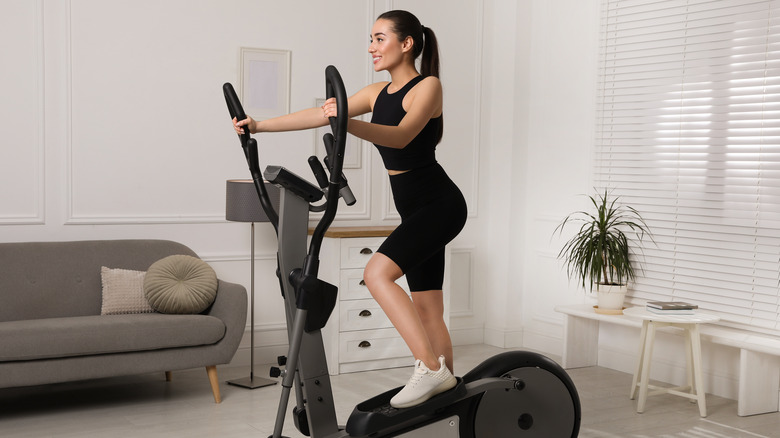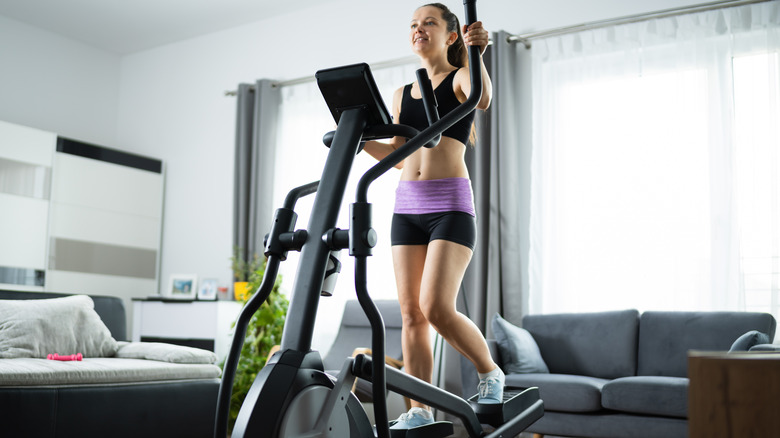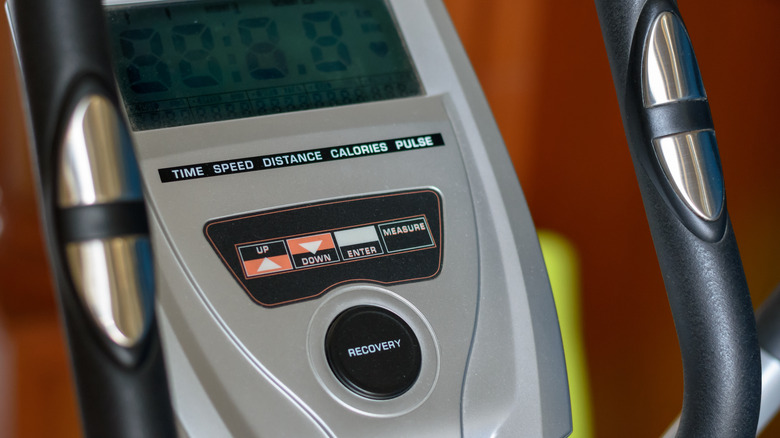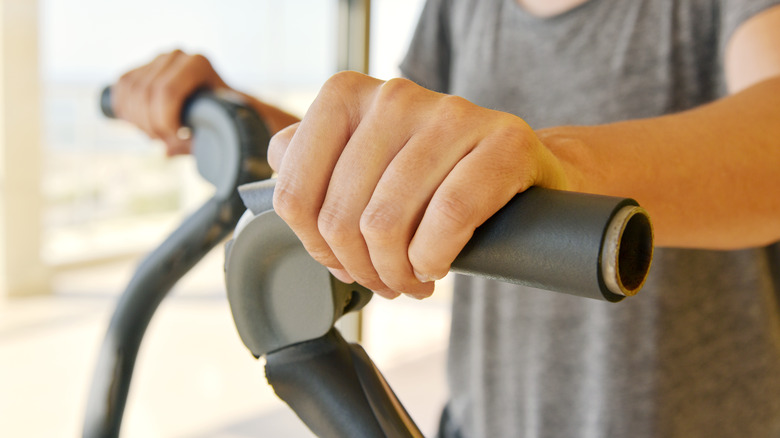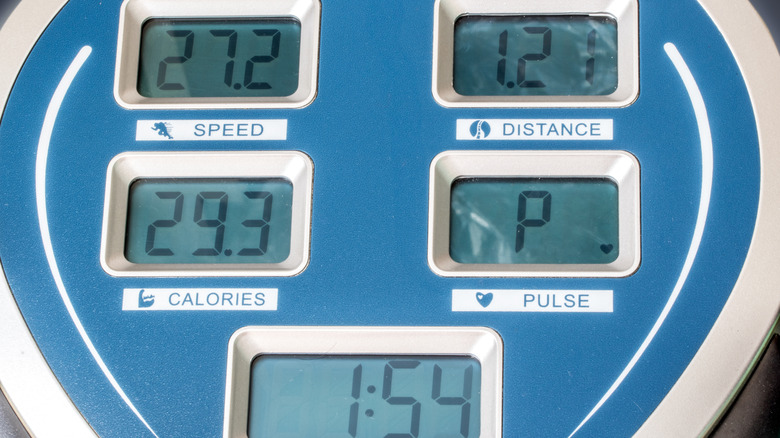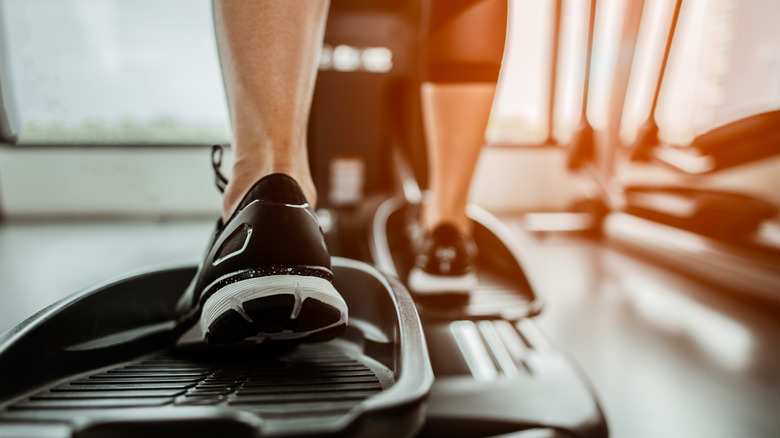The Worst Mistakes Everyone Makes On The Elliptical
When walking into any gym or training facility, you're likely to see rows of cardio equipment, including treadmills, stationary bicycles, stair climbers, and ellipticals. Ellipticals, commonly referred to as cross trainers, elliptical trainers, or gliders, allow you to walk, run, or climb without pressure on your joints. That will enable you to spend more time focusing on your upper body, as many ellipticals are equipped with movable handles to get your arms and shoulders in motion, too (via Byrdie).
According to Byrdie, an elliptical workout requires the engagement of several muscles, including quads, hamstrings, glutes, adductors, abductors, biceps, triceps, and more. Thus, it's a full-body workout. For example, a 30-minute workout can burn roughly 450 calories when performed with moderate effort by a person of average weight. With the ability to burn so many calories in such a short time, the elliptical is great if you're short on time.
The elliptical has many benefits, including increased stamina, expanded cardio capacity, reduced pressure on joints, utilization of lower and upper body muscles, ease of use, and improved balance (via Healthline). However, make sure you're not making these mistakes when you're using the machine.
Bad form
Many slouch on the elliptical, which can cause lower back injuries. Avoid slouching by engaging your core muscles. Stand tall, use the moving handles, and avoid leaning on the machine (via Prevention).
Putting pressure on your toes or balls of your feet is another major mistake. According to PopSugar, distributing too much weight to the front of your feet and front of the pedals can cause your feet to go numb, put unwanted pressure on your knees, and cause long-lasting injuries. In addition, without sensation in your feet, your workout is probably going to be cut short.
The Healthy says preventing weight distribution issues is as simple as imagining that you're jogging. Ellipticals were designed to imitate a run, save for the amount of stress on your joints. Begin by pedaling with the balls of your feet, continue the motion throughout your foot, and end the motion with your heels, keeping your foot flat on the pedals.
Using the same resistance and incline
To get an effective sweat session, there must be some amount of resistance. Specifically, it should be set at almost anything except zero. Using the elliptical with a low resistance or incline won't give you the workout you need, especially since low resistance is a cakewalk for most people. Instead of aiming for a faster speed at low resistance, a higher resistance at a medium speed will give you a quality elliptical workout, per Healthination. While the higher resistance means that you won't be as fast as you'd be at the minimum resistance level, the additional challenge would still make for a better burn.
Just because you introduce resistance to your elliptical routine doesn't mean you should limit yourself to a single resistance level. Since it's easy to get comfortable on the elliptical, you should acknowledge when your body can handle an increase in intensity. To avoid hitting a plateau and keep evolving on your fitness journey, you must continually increase your resistance (via Healthination).
Increasing your resistance shouldn't be a daunting process. Instead, listen to your body and attempt to gradually improve over time. The goal is to keep your body moving during moderate but not impossible workouts (via The Healthy).
Leaning on the handles
Ellipticals either have moving handles or static handles. According to The Healthy, slouching on an elliptical's static handles is one of the most frequent elliptical mistakes. Leaning on the static handles for support doesn't do anything to enhance your workout. Rather than your entire body supporting itself, these handles serve as a crutch since your body thinks it's no longer responsible for stability. Ultimately, holding on to these handles during your time on the elliptical can put you more at risk of injuries such as musculoskeletal issues and lower-back pain (via PopSugar).
Moving handles have proven to be more beneficial than static handles. According to PopSugar, you can hang on to these handles as long as you're aware of your posture, you utilize upper body muscles to drive the handles, and you take breaks from the handles during your workout. If you're not a fan of the moving handles, you don't have to incorporate them into each elliptical session. Instead, Prevention recommends using the handles two days a week for a good arm and shoulder burn.
Relying too much on the machine's information
Elliptical machines typically use your age, weight, and height to determine your heart rate, distance traveled, and how many calories you burn. Shockingly, some machines don't even take that much information into consideration (via PopSugar).
The Healthy points out watching your calories burned can be motivating, but these numbers are often incorrect, sometimes to a great extent. So unless you can input your information, avoid relying too much on the machine's numbers.
One alternative is to use a fitness tracker. A tracker will use your heart rate to estimate how many calories you've burned while on the elliptical. Put your personal information in your fitness tracker's app, in order to get the correct amount of calories burned and heart rate. PopSugar recommends getting an elevated heart rate for 15 to 20 minutes during your elliptical training. Furthermore, with a fitness tracker, you'll have a log of your workouts, along with the days and time you spent exercising.
Bouncing
Similar to our natural inclination to hold on to the elliptical's static handles, it's easy to find ourselves in a bouncing rhythm while using the machine. However, allowing your weight and gravity to do the work for you means cheating yourself out of a quality elliptical workout (via the Washington Post).
The faster you go, the greater possibility of the bouncing effect, according to Livestrong. The additional momentum prevents your muscles from being completely engaged during the workout. As a result, your legs will miss out on strength building, and your performance will suffer since you won't burn as many calories. Pay close attention to your strides per minute. It's okay to operate at high speed, but make sure you're not compromising your form. When you find yourself bouncing, slow down your pace.
Your stance is also critical. Stand up straight, relax your shoulders, ensure your shoulders and hips are aligned, loosely grip the handles, and drive through your heels. By not staying on the balls of your feet, your upper body will stay in proper form, and your entire body will operate at a level position. As a result, you'll significantly reduce the unnecessary impact on your joints, greatly enhancing your performance.

